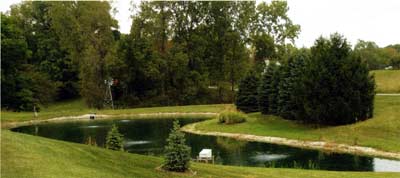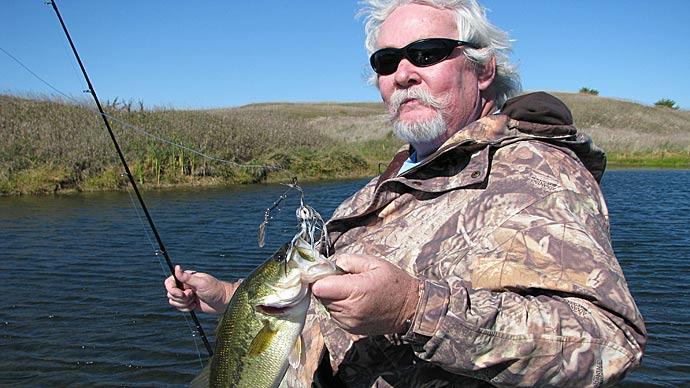
Some sportfish pond owners feed their fish to improve production and to have larger fish to catch. However, nutrients in feeds are not totally converted to fish. Nitrogen and phosphorus from feeds stimulate phytoplankton growth, and organic waste from feeds increases oxygen demand. A discussion of the effects of feeds on water quality in sportfish ponds should be of interest to those who apply feeds to their fish ponds.
Feeds are widely used in commercial aquaculture to increase production per unit area more often than possible with fertilizer additions. Most species' feeding rate in ponds cannot be increased above 30-40 pounds per acre per day without dense phytoplankton blooms developing and causing low dissolved oxygen concentrations, particularly at night. Of course, mechanical aerators are put into ponds to increase the availability of dissolved oxygen and allow more feed to be applied and greater production to be realized.
Feeds are made of plant meals, fish meal or animal byproduct meals, or both, vitamins, and other additives. Sportfish feeds contain about 40% protein and around 1% phosphorus. For example, a good quality sportfish feed advertised online contains a minimum of 43% crude protein (6.88% nitrogen) and 1.1% phosphorus. Fish typically require about 1.5-2.0 pounds of feed for each 1.0 weight gain. Live fish biomass contains about 2.8% nitrogen and 0.9% phosphorus. At a feed conversion ratio (FCR = feed applied three weight gain) of 2.0, each pound of feed results in a 0.5-pound gain in fish biomass.
It is important to note that fish feed pellets typically contain about 10% water and 90% dry matter, while fish are about 75% water and 25% dry matter. Because of this, an FCR of 1.0 would not suggest that all the feed dry matter, became fish dry matter. In fact, at FCR = 1.0,0.9-pound dry matter in feed (1.0 pound of feed) would result in only 0.25-pound dry matter in fish (1.0-pound live fish). The difference of 0.65 pounds between feed dry matter and fish dry matter would consist of organic matter in feed used as an energy source in fish respiration, fecal and other metabolic excretions, and any feed that was applied but not eaten. A dry matter FCR can be calculated by dividing feed matter (0.9 pounds) by fish dry matter (0.25 pound). The dry matter FCR is 3.6 compared to 1.0 by the standard way of calculating FCR. The upshot is that most feed becomes waste and enters the pond.
Each pound of the feed mentioned earlier contains 0.0688 pounds of nitrogen and 0.011 pounds of phosphorus. Each pound of biomass resulting from the use of feed contains 0.028-pound nitrogen and 0.009-pound phosphorus. Thus, for each pound of feed applied at an FCR of 1.5 (1.5-pound feed = 1 pound biomass increase), 0.0752-pound nitrogen and 0.017-pound phosphorus (0.039-pound P205 equivalent) will enter the pond.
At the FCR of 1.5, in 1 month of daily feeding at 10 pounds per acre per day, the nitrogen and P205 inputs would be 22.6 and 5.1 pounds per acre of P205. This is equal to the fertilizer nitrogen and P205 inputs to many ponds, which are treated with commercial fertilizers.

In sportfish ponds, fish eat natural food organisms, and the feed is only a nutritional supplement. This fact makes it difficult to know the actual FCR because the fish are also increasing in biomass weight because of the natural food.
The nitrogen and P205 fertilizer input equivalents of 1 pound of feed daily per month at different FCRs are provided in Table 1. Values for a particular FCR in Table 1 may be multiplied by the daily feed input to obtain the fertilizer equivalents. Notice that the equivalents for 10 pounds of feed per day would range from 12.2 pounds of nitrogen and 1.4 pounds P205 at FCR = 1.0 to 32.9 pounds of nitrogen and 8.9 pounds P205 at FCR = 2.0. Feeding sportfish ponds can result in a large input of nitrogen and phosphorus, especially where the FCR is high.
In addition to nutrients, feeds also result in oxygen demand. The potential oxygen demand from the feed is approximately 1.1 pounds of dissolved oxygen per pound of feed. Thus, in a pond of 1 acre which is 5 feet in average depth, 10 pounds of feed per day might remove up to 0.75 mg/L of dissolved oxygen daily.
As already mentioned, low dissolved oxygen concentration may result in commercial fish ponds without aeration when the feeding rate exceeds 30 pounds per acre daily. These ponds are not treated with commercial fertilizer, as often is the practice for sportfish ponds. Therefore, the daily feeding rate necessary to cause an elevated risk of dangerously low nighttime dissolved oxygen concentration would be less in a sportfish pond where commercial fertilizers are applied.
Feeding is an excellent method for increasing fish production and the size of fish in pond culture. However, it results in a greater risk of excessive phytoplankton blooms and low dissolved oxygen concentration—especially at night. Therefore, those who apply feed to their ponds should pay close attention to the abundance of phytoplankton, and measuring nighttime dissolved oxygen concentration would be helpful. Fertilization rates certainly should be adjusted as necessary to avoid excessive blooms.
Mechanical aerators can be installed in ponds to reduce the low dissolved oxygen concentration risk. With most aeration systems, about one horsepower of aerator capacity per acre will suffice for around 500 pounds per acre of fish biomass. Aeration usually is needed only during the night, but continuous aeration may be necessary to avoid thermal stratification.
Dr. Claude Boyd is an emeritus professor in the School of Fisheries, Aquaculture and Aquatic Sciences, Auburn University, Auburn, Alabama 36849. His work with water quality is internationally renowned. His most recent book, Handbook for Aquaculture Water Quality, is a must for anyone interested in learning about water chemistry and how it relates to your pond. It's technical and thorough but easy to read and understand. Buy it at www.pondboss.com in the online store.
Reprinted with permission from Pond Boss Magazine



